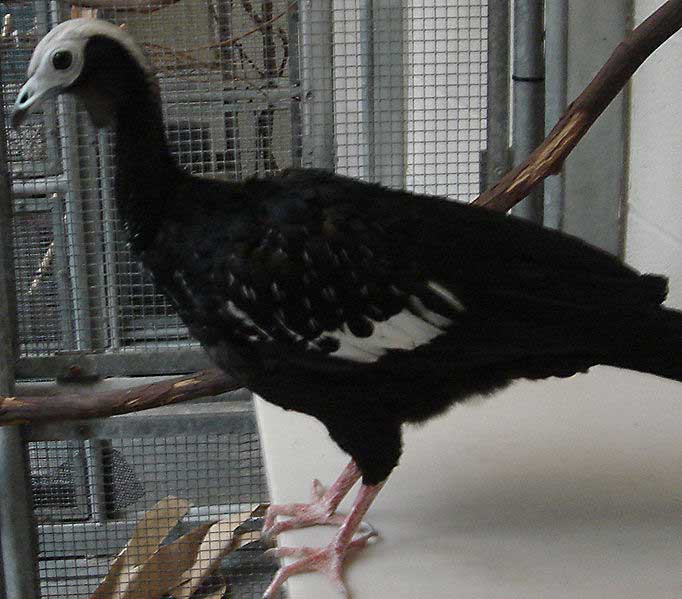Pipile cumanensis Cladus: Eukaryota Name Pipile cumanensis (Jacquin, 1784) The Blue-throated Piping Guan, Pipile cumanensis is a South American bird of the family Cracidae that is somewhat similar in appearance to the turkey.
There are two subspecies. P. cumanensis cumanensis (Jacquin, 1784) is found from the Guyanas, the Orinoco river in Venezuela, and southeastern Colombia south to northwestern (Amazonian) Brazil and southeastern Peru. There and possibly in northern Bolivia it intergrades with the bigger P. cumanensis grayi (Pelzeln, 1870) (Gray's Piping-guan), which continues through northern and central Bolivia, Mato Grosso State of Brazil, and northern and eastern Paraguay.[1] This species occurs locally in forests: in Colombia and Venezuela, humid lowland forests (occasionally as high as 1000 meters) whether seasonally flooded or not, and riparian forests. It especially favors the edges where the forest meets open land or a river.[2][3] The Blue-throated Piping Guan is described as "oddly 'prehistoric' (reptilian)" but "handsome".[2] It averages 69 cm (27 inches) long, including its neck and tail, both long, the neck and head disproportionately thin and small, the tail disproportionately big. Most of the plumage is black with a greenish gloss—blue-green in cumanensis, olive in grayi. It has a large white patch on each wing, white flecks on the wing coverts and chest, a white patch over the eye, and a white or buffy-white nape (and upper neck in grayi). Both subspecies have a short white or buffy-white crest; in cumanensis it is shaggy and nearly solid-colored; in grayi it is hairier, and the feather shafts are black, appearing as streaks. The bill is baby-blue at the base and cobalt-blue at the tip. Both subspecies have blue bare flesh on the throat with a wattle in cumanensis and a hanging caruncle in grayi. The legs are red.[1][2][3] During the breeding season it is noisy. At dawn it gives a "piping" call of 6 or so slow high-pitched, clear whistles, "slightly ascending in pitch, püüeee, püüeee, püüeee,…", reminiscent of the Scale-backed Antbird. Its flight display, at dawn or in the daytime, includes "2 quick wing-claps (often barely audible), then 2 whirring rattles with wings," the second seeming to reverse the first as in shuffling cards (Colombia and Venezuela). At other seasons it is usually silent.[2] Behavior This species occurs in pairs during the breeding season and bigger groups, as many as 12, at other times. It walks nimbly or hops with help from its wings in the canopy or sub-canopy of the forest, especially in trees with flowers or fruit that it eats. To cross clearings it sets off with fast wingbeats and then glides, giving another flurry of wingbeats if needed to maintain its height. Where not hunted it is fairly common and easy to see.[2][3] Little is known about its reproduction. In Colombia it has been observed in breeding condition in February and laying eggs in May. One nest was built of twigs in thick vegetation in the canopy and contained three yellowish-white eggs.[3] Taxonomy Instead of a species, the Blue-throated Piping Guan is sometimes considered to be two subspecies of Pipile pipile,[1][2][3] a name that is here restricted to the Trinidad Piping Guan. Authorities disagree, as does recent evidence. A genetic study suggests a split,[4] but free interbreeding between this species (grayi) and the Red-throated Piping Guan in eastern Bolivia, creating a "hybrid swarm", suggests a lump.[5] ^ a b c Blake, Emmet R. (1977). Manual of Neotropical Birds. Volume 1: Spheniscidae (Penguins) to Laridae (Gulls and Allies). University of Chicago Press. p. 416. ISBN 0-226-05641-4. Retrieved 2007-10-20.
Source: Wikipedia, Wikispecies: All text is available under the terms of the GNU Free Documentation License |
|

